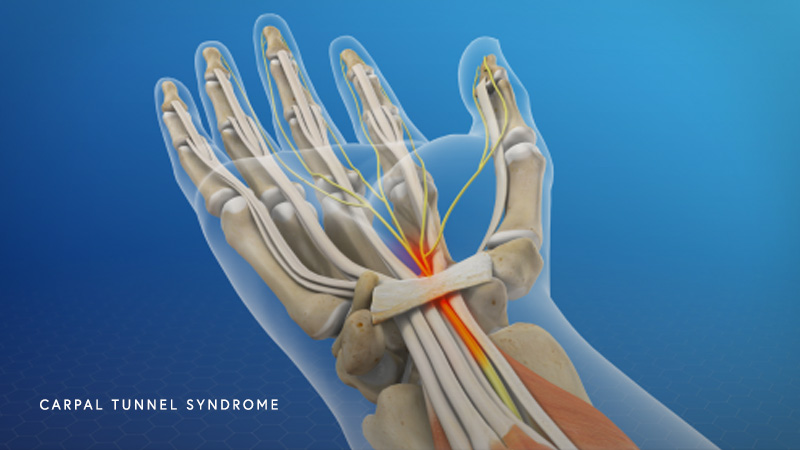Carpal Tunnel Syndrome
The carpal tunnel is a narrow channel in the wrist that protects the median nerve and flexor tendons, which allow the fingers and thumb to bend.
Small bones called carpal bones make up the base and sides of the carpal tunnel. A band of strong connective tissue called the transverse carpal ligament comprises the roof of the carpal tunnel, which measures about an inch wide. Because the carpal tunnel is surrounded by ligament and bones, it is limited in its capacity to stretch or expand.
The median nerve, which runs through the carpal tunnel, gives feeling to the palm side of the thumb and all fingers, except the small “pinky” finger. It also provides signals to control the muscles at the base of the thumb. The median nerve originates at the neck from a group of nerve roots and merges to form a single nerve in the arm, which moves down and passes through the carpal tunnel and into the hand.
Carpal tunnel syndrome is a condition that occurs when pressure is put on the median nerve due to narrowing of the carpal tunnel (often due to a fracture) or swelling of the tissue around the tendons. The tissue, called synovium, helps lubricate the tendons, but when it becomes inflamed, it can swell and crowd the median nerve. Carpal tunnel syndrome can result in numbness, tingling, pain and weakness in the wrist and hand.

There are many causes of carpal tunnel syndrome, and often, the condition is brought on by a combination of factors. People who perform work or activities that involve repetitive hand and wrist motion are at higher risk for carpal tunnel syndrome. Studies also suggest that women and elderly people are more susceptible to the condition. Causes and risk factors include:
- Repeating the same hand and wrist motions for prolonged periods of time. Working long term with tools that cause vibration, can also be a risk factor.
- Activities that involve extreme flexion or extension of the hand and wrist can increase pressure on the nerve.
- Heredity can play a role, as some people may have smaller carpal tunnels, giving the median nerve less space.
- Pregnancy can bring on hormonal changes that cause swelling.
- Some health conditions, including inflammatory disorders like rheumatoid arthritis, can cause carpal tunnel syndrome. Other conditions associated with the syndrome include diabetes, kidney failure, lymphedema and thyroid disorders.
Symptoms of carpal tunnel syndrome may begin gradually and take time to notice. However, as the condition progresses, symptoms may become more frequent and persist longer. Common symptoms include:
- Numbness or tingling of the hand or thumb, index, middle or ring fingers
- Sensations like a shock that radiate into the hand and fingers
- Tingling or numbness in the forearm
- Weakness in the hand
- Lack of sensation of touch in the hand
Symptoms may worsen when holding something such as a phone, steering wheel, or book for extended periods of time. Symptoms often occur at night, particularly since many sleeps with their wrists bent.
Your doctor will discuss your medical history and symptoms, and conduct a series of tests to determine if you have carpal tunnel syndrome.
Physical Examination
Your physician will conduct a physical examination with several physical tests. The doctor will likely bend your wrist and tap on the median nerve to see if it causes any numbness or tingling in your fingers. The doctor will also test sensitivity in your fingers and hands and check for weakness around the base of your thumb.
Electrophysiological Tests
Your doctor may use electrophysiological tests to determine how well your median nerve and hand muscles are working. An electromyography test, or EMG, measures your muscles’ electrical activity. This test can help identify any damage to the muscles controlled by the median nerve. Your doctor may also conduct a nerve conduction study, which tests the medial nerve to determine if electrical impulses are slowed in the carpal tunnel.
X-Rays
If you have pain or limited movement in your wrist, x-rays may be used to exclude other conditions such as fractures, ligament injury or arthritis. Because x-rays provide images of dense structures, like bone, your doctor would use x-rays to rule out other potential conditions, not to make a diagnosis of carpal tunnel syndrome.
Other Imaging Tests
Your doctor may use ultrasound or magnetic resonance imaging (MRI) scans to evaluate the median nerve and surrounding tissue. An MRI can also help rule out other issues such as damage from an injury or a tumor.
Symptoms of carpal tunnel syndrome are best treated as soon as they arise. Without treatment, the condition will worsen over time. However, if caught early, simple interventions can be effective, including:
- Taking breaks from repetitive work
- Avoiding activities that aggravate symptoms
- Applying ice packs to the affected area to reduce swelling
In addition, your doctor may recommend non-surgical therapies such as wrist bracing or splinting, NSAIDs (nonsteroidal anti-inflammatory drugs), corticosteroids and nerve gliding exercises for the median nerve.
If non-surgical therapies are not successful, your doctor may recommend surgery. The surgery performed is called a “carpal tunnel release,” wherein the ligament on the roof of the carpal tunnel is cut to relieve pressure on the median nerve.
Finding treatment options for carpal tunnel syndrome
At the Center for Orthopaedic Specialists, our doctors are experts in the treatment of carpal tunnel syndrome. We employ personalized interventions for our patients to get them moving again, free of debilitating pain and numbness. If you are currently experiencing any carpal tunnel syndrome-related symptoms or require treatment, contact the Center for Orthopaedic Specialists today!




 / 50 Reviews
/ 50 Reviews